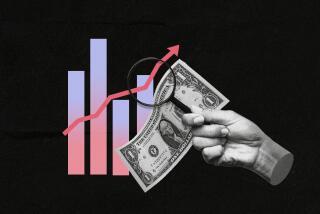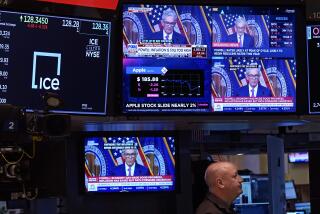Americans Said Better Off Than Key Rate Shows : Savings: Conference Board report says focusing on what people sock away is misleading as a measure of household wealth.
- Share via
NEW YORK — Americans have a greater store of wealth than what is suggested by the government’s paltry saving estimate, a new study by the Conference Board shows.
Often near the bottom in international surveys of saving rates, the government figures Americans sock away just $4.20 of every $100 they earn, a 4.2% savings rate.
But consumers have actually witnessed a sharp rise in the value of real and financial assets they own, making the government figure misleading, said Albert Sommers, senior economic adviser at the board and author of the study.
“The fact is that the personal saving rate says little or nothing about the actual condition of the household sector that is presumed to be doing the saving,” Sommers wrote.
Several problems with the saving rate emerge, not the least of which is that it measures the difference between total spending and after-tax personal income.
It fails to capture the appreciation of real and financial assets that can often have a powerful influence on household wealth and spending.
Under the conventional measurement, the U.S. saving rate of 4.2% falls well short of Japan’s 15.4% and Germany’s 13.1%.
While the measured U.S. personal saving rate is about $200 billion a year, Sommers notes that total financial assets of American households now appear to be an astounding $15.5 trillion. When it comes to net financial worth--financial assets, less debt--Americans have close to $10 trillion.
If one uses comparable data for other countries, the United States comes out well ahead in savings.
“The ratio of net financial wealth to disposable income is substantially higher in the U.S. than in any of the other G-7 countries,” Sommers said. The Group of Seven industrialized countries includes Britain, Canada, France, Germany, Italy, Japan and the United States.
In the past several years, a period characterized by a growing sense of doubt and pessimism over America’s competitive position in the global economy, U.S. households chalked up impressive investment returns.
From 1991 to 1993, individuals invested about $270 billion in net new securities purchases and saw their investment portfolios rise in value by a whopping $1.85 trillion, the study notes.
The shift by consumers out of low-yielding bank deposits and into mutual funds has played an important role in the investment gains and highlights yet another shortcoming with the narrowly focused personal saving rate.
“For these reasons, among others, the change in the total financial net worth of the household sector has been very much larger than is implied by the simple saving rate,” Sommers said.
Aside from casting doubt on the usefulness of the way savings are reported, the study has implications for U.S. growth prospects as well.
While economists generally focus on income and jobs growth as key determinants of consumer spending, personal wealth also plays a role.
“The low personal saving rate does not, by itself, suggest that personal outlays for consumption . . . are bound to be weak in the future,” Sommers said.
“Wealth is a very important determinant of spending and often outweighs the personal saving rate and some other elements included in the national income accounts.”
More to Read
Inside the business of entertainment
The Wide Shot brings you news, analysis and insights on everything from streaming wars to production — and what it all means for the future.
You may occasionally receive promotional content from the Los Angeles Times.










